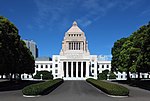Kokkai-gijidō-mae Station
Internal link templates linking to redirectsRailway stations in Japan opened in 1959Railway stations in TokyoStations of Tokyo MetroTokyo Metro Chiyoda Line ... and 1 more
Tokyo Metro Marunouchi Line

Kokkai-gijidomae Station (国会議事堂前駅, Kokkai-gijidō-mae-eki) is a subway station in Chiyoda, Tokyo, Japan, operated by the Tokyo subway operator Tokyo Metro. It is located adjacent to the National Diet Building. The station name literally means "in front of the National Diet Building".
Excerpt from the Wikipedia article Kokkai-gijidō-mae Station (License: CC BY-SA 3.0, Authors, Images).Kokkai-gijidō-mae Station
Metropolitan Road 247, Chiyoda
Geographical coordinates (GPS) Address Nearby Places Show on map
Geographical coordinates (GPS)
| Latitude | Longitude |
|---|---|
| N 35.674119 ° | E 139.745246 ° |
Address
衆議院分館
Metropolitan Road 247
100-0014 Chiyoda
Japan
Open on Google Maps









